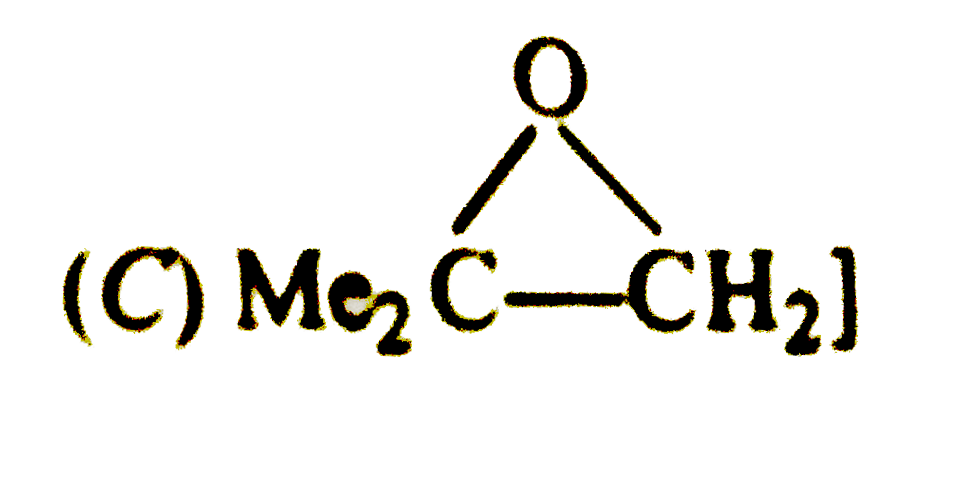Complete the missing links
CH3CHBrCH3alc. KOH−−−−→XHBr, Peroxide−−−−−−−→YCH3ONa−−−−−→Z
XYZCH3CH=CH2CH3CH(Br)CH2BrCH3CH(OH)CH3
XYZCH3CH=CH2CH3CH2CH2BrCH3CH2OCH2CH3
XYZCH3CH=CH2CH3CH(Br)CH3CH3CH2OCH2CH3
XYZCH3CH=CH2CH3CH2CH2BrCH3CH2CH2OCH3
The correct Answer is:D
To solve the problem, we need to identify the compounds X, Y, and Z in the given reaction sequence. Let's break down the steps:
Step 1: Identify Compound X
We start with the compound \( CH_3CHBrCH_3 \) and treat it with alcoholic KOH.
- Reaction Type: Alcoholic KOH is a strong base and promotes elimination reactions (dehydrohalogenation).
- Elimination: The elimination of HBr occurs, where the Br leaves and a hydrogen atom from the adjacent carbon is also removed.
The structure of the starting compound can be represented as:
CH3|CHBr|CH3
After elimination, we will form a double bond between the first and second carbon atoms:
CH3∣CH=CH2
Thus, compound X is:
\( X = CH_3CH=CH_2 \)
Step 2: Identify Compound Y
Next, we treat compound X with HBr in the presence of peroxide.
- Reaction Type: The presence of peroxide leads to the anti-Markovnikov addition of HBr.
- Mechanism: The bromine atom will add to the less substituted carbon atom (the one with more hydrogen atoms), while the hydrogen will add to the more substituted carbon.
Starting with:
CH3∣CH=CH2
The addition of HBr will yield:
CH3∣CH2Br
Thus, compound Y is:
\( Y = CH_3CH_2CH_2Br \)
Step 3: Identify Compound Z
Finally, we treat compound Y with \( CH_3ONa \) (sodium methoxide).
- Reaction Type: This reaction is a Williamson ether synthesis.
- Mechanism: The bromine atom is a good leaving group and will leave, allowing the methoxide ion (\( CH_3O^- \)) to attack the carbon atom where the bromine was attached.
Starting with:
CH3∣CH2Br
After the reaction, we get:
CH3∣CH2OCH3
Thus, compound Z is:
\( Z = CH_3CH_2CH_2OCH_3 \)
Summary of Compounds
- X: \( CH_3CH=CH_2 \)
- Y: \( CH_3CH_2CH_2Br \)
- Z: \( CH_3CH_2CH_2OCH_3 \)
We start with the compound \( CH_3CHBrCH_3 \) and treat it with alcoholic KOH.
- Elimination: The elimination of HBr occurs, where the Br leaves and a hydrogen atom from the adjacent carbon is also removed.
The structure of the starting compound can be represented as:
CH3|CHBr|CH3
CH3∣CH=CH2
\( X = CH_3CH=CH_2 \)
Next, we treat compound X with HBr in the presence of peroxide.
- Mechanism: The bromine atom will add to the less substituted carbon atom (the one with more hydrogen atoms), while the hydrogen will add to the more substituted carbon.
CH3∣CH=CH2
CH3∣CH2Br
\( Y = CH_3CH_2CH_2Br \)
Finally, we treat compound Y with \( CH_3ONa \) (sodium methoxide).
- Mechanism: The bromine atom is a good leaving group and will leave, allowing the methoxide ion (\( CH_3O^- \)) to attack the carbon atom where the bromine was attached.
CH3∣CH2Br
CH3∣CH2OCH3
\( Z = CH_3CH_2CH_2OCH_3 \)
- X: \( CH_3CH=CH_2 \)
- Y: \( CH_3CH_2CH_2Br \)
- Z: \( CH_3CH_2CH_2OCH_3 \)
Similar Questions
Knowledge Check
Supply structural formulae for missing compounds.
(i) H2C=CH2+(A)→ClCH2−CH2OHH2SO4−−−−−−→413K(B)alc. KOH−−−−−−−→Δ(C)
(ii) CH3CHBrCH3alc. KOH−−−−→(A)HBr−−−−−→Peroxide(B)CH3ONa−−−−−→(C)
(iii) Me3CBralc. KOH−−−−→(A)HOCl−−−→(B)NaOH−−−→(C)
 AABCCH3CH=CH2CH3CH(Br)CH2BrCH3CH(OH)CH3BABCCH3CH=CH2CH3CH2CH2BrCH3CH2OCH2CH2CABCCH2CH=CH3CH3CH(Br)CH3CH3CH2OCH2CH2DABCCH2CH=CH3CH3CH2CH2BrCH2CH2CH2OCH3
AABCCH3CH=CH2CH3CH(Br)CH2BrCH3CH(OH)CH3BABCCH3CH=CH2CH3CH2CH2BrCH3CH2OCH2CH2CABCCH2CH=CH3CH3CH(Br)CH3CH3CH2OCH2CH2DABCCH2CH=CH3CH3CH2CH2BrCH2CH2CH2OCH3Complete the missing links .
ACH3MgBr−−−−−→BH3O+−−−→CACH3COCH3(CH3)3COMgBr,(CH3)3COHBCH3COOH,(CH3)CHOMgBr,CH3CH2OHC(CH3COO)2Ca,CH3CH2OMgBr,CH2CH∣OH−CH3DCH3COOCH3,(CH3)3COMgBr,CH3−CH∣OH−CH3
Identify A and B in the CH3CH2CH2Bralc. KOH−−−−→AHBr−−→B.
View SolutionComplete the following
CH3COCH2CH3+HIRedP/423K−−−−−−−→
View SolutionIn the following sequence of reactions,
CH3CH2CH2BrKOH(Alc)−−−−−−→ (A) HBr−−→ (B) KOH(aq)−−−−−→ (C ) The product (C) is
View SolutionComplete the following reactions
CH3CH=CH2mCPBA−−−−→AC2H5MgBr−−−−−−→H3O+B
View SolutionIdentify Z in the following series
CH2=CH2HBr−−→XHydrolysis−−−−−−→YNa2CO3−−−−→I2excessZ
View SolutionConsider the following sequence of reaction and identify the final product (Z).
CH3CH2CH2BrMg dry ether−−−−−−−→(X)CO2−−→(Y)H+−−→(Z)
View Solution
